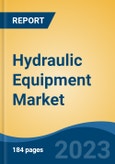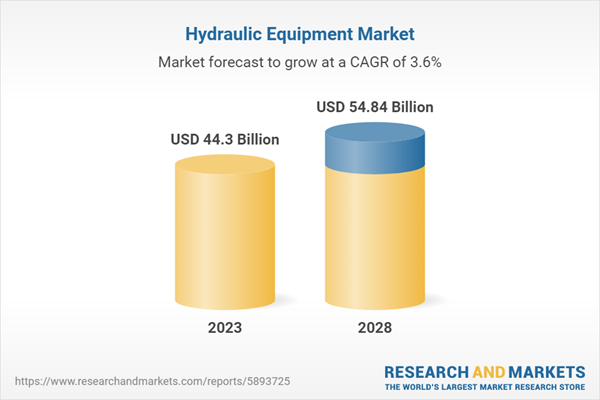Free Webex Call
The Global hydraulic equipment market is anticipated to grow at a steady pace during the forecast period, 2023-2028. The development of process industries, increased demand for material handling equipment, and the potential growth of the construction industry are the main drivers of the global hydraulic equipment market. Additionally, technological advancements that increase the demand for intelligent hydraulics equipment are assisting in the development of hydraulics equipment. Speak directly to the analyst to clarify any post sales queries you may have.
10% Free customizationThis report comes with 10% free customization, enabling you to add data that meets your specific business needs.
Pressurized fluid is used by hydraulic machinery to carry out a variety of machining operations. A pump is driven by an engine or motor, which presses the hydraulic fluid in hydraulic machinery. The actuators of the machine receive this fluid through hydraulic tubes, and they employ the pressure of the fluid to finish the operation at hand.
Modern Technology in Hydraulic Equipment Applications
Even though the Internet of Things' typical applications center around electric systems, it is also used in fluid power systems. Hydraulic equipment is increasingly using electronics for intelligent mobility and sensors for data collection. The provision of a wide range of electro-hydraulic modules and components with digital interfaces and sensor intelligence is another way in which manufacturers support the digitalization of hydraulic goods. Modern technology in hydraulic applications offers intelligent design, configuration, and precision control for hydraulic systems, which benefits manufacturers. Now, end users may control every aspect of a computer via a single user interface.The material handling business has witnessed numerous changes during the past 70 years that have altered the future for the sector. Individual workers have been replaced by robots and material-handling equipment. Numerous industries have expanded as a result of this transformation, particularly the automotive sector, which has increased by ten times.
The demand for hydraulic equipment is anticipated to increase during the forecast period due to the expanding construction sector. For instance, a World Bank analysis estimated that USD 12.4 trillion would be spent on construction globally in 2021. Additionally, during the forecast period, it is anticipated that in emerging economies such as India, the potential for 100% foreign direct investments (FDI) in township and settlement projects will increase the demand for hydraulic construction machinery, including hydraulic cranes, excavators, and loaders.
In comparison to electrical and mechanical systems, hydraulic systems employ liquid (often oil) to transport power and offer a few advantages. Pumps, actuators, valves, cylinders, and motors are a few examples of hydraulic components. The limitless availability of the source, ease of control, safety, ease of maintenance due to the lack of moving parts, and ease of use are the main benefits of hydraulic components. Water pistons, wheelchair lifts, automotive braking systems, boat rudders, airplane wing flaps, and other hydraulic system applications are just a few examples. It is anticipated that the demand for hydraulic components will increase significantly during the forecast period. Additionally, almost every industry is adopting automation and artificial intelligence to reduce the need for human labor, modernize, and enhance the effectiveness and performance of products.
Consequently, hydraulic applications increasingly require integrated sensors and control capabilities. For instance, a comprehensive provider of hydraulic components from Germany, Weber-Hydraulik, presented development concepts and options for integrated sensors for hydraulic cylinders in April 2019. These sensors incorporate an electrical module for picture processing and communication and help to detect the position of cylinders. Leaks both internal and external can have a big impact on hydraulic parts. As a result, automated items are required to boost their effectiveness.
Construction Segment to Witness Significant Growth
A pressurized fluid is used by hydraulic equipment to operate and carry out activities. A confined fluid transmits the applied pressure without being decreased. Each component in a segment of the holding vessel is affected by the pressurized fluid, which produces force or power. Hydraulics enabled the creation of much more accurate motions as technology advanced. With such accuracy, there is growing momentum for further process optimization in the construction industry.Hydraulics' introduction to the construction sector has considerably increased productivity, enabling more work to be completed in less time. The equipment was able to move in a range of directions and be precisely controlled thanks to the study of hydraulics. The use of hydraulic equipment is a crucial component of the contemporary construction industry, and as technology develops further, its significance will grow. The hydraulic machinery is capable of handling and transferring heavy loads. Hydraulic equipment has fewer moving and load-bearing components than other systems that primarily rely on mechanical ones. Most functional restrictions are handled by the hydraulic fluid, motors, and pumps at either end. The hydraulic equipment operates more effectively and performs in a controlled manner due to the use of intelligent valves, pumps, and other components. Additionally, it aids in automating the procedure.
The Indian economy depends heavily on the building industry. The government puts a strong emphasis on the construction sector because it is crucial to drive India's overall growth and due to this it can help in nation develops. Despite the disruptions in India's construction industry, there is hope for the future due to the initiatives and procedures being developed to support major projects. For instance, Honey Group unveiled 33 projects in one day in April 2022, including nine projects in Telangana and 24 projects in Andhra Pradesh, setting a standard for the construction sector.
Market Segmentation
The global hydraulic equipment market is segmented based on type, end-user industry, and region. Based on type, the market can be segmented into pumps, valves, cylinders, motors, filters & accumulators, and transmission. Based on end-user industry, the market is segmented into construction, agriculture, material handling, aerospace & defense, machine tools, oil & gas, hydraulic press, plastics, and automotive. Based on region, the market is segmented into North America, Asia-Pacific, Europe, South America, and Middle East & Africa.Market Players
Major market players in the global hydraulic equipment market are Bosch Rexroth AG (ROBERT BOSCH GMBH), Parker-Hannifin Corporation, Hydac International Gmbh, Danfoss AS, SMC Corporation, Festo SE (Festo Beteiligungen GmbH & Co. KG), Norgren Limited (IMI PLC), Bucher Hydraulics (Bucher Industries AG), HAWE, and Linde Hydraulics GmbH & Co.Report Scope:
In this report, the global hydraulic equipment market has been segmented into following categories, in addition to the industry trends which have also been detailed below:- Hydraulic Equipment, By Type:
- Pumps
- Valves
- Cylinders
- Motors
- Filters & Accumulators
- Transmission
- Hydraulic Equipment, By End-user Industry:
- Construction
- Agriculture
- Material Handling
- Aerospace & Defense
- Machine Tools
- Oil & Gas
- Hydraulic Press
- Plastics
- Automotive
- Hydraulic Equipment, By Region:
- North America
- United States
- Canada
- Mexico
- Asia-Pacific
- China
- India
- Japan
- South Korea
- Indonesia
- Europe
- Germany
- United Kingdom
- France
- Russia
- Spain
- South America
- Brazil
- Argentina
- Middle East
- Saudi Arabia
- South Africa
- UAE
- Israel
Competitive Landscape
Company Profiles: Detailed analysis of the major companies present in the global hydraulic equipment market.Available Customizations:
With the given market data, the publisher offers customizations according to a company's specific needs.This product will be delivered within 1-3 business days.
Table of Contents
1. Product Overview
2. Research Methodology
6. Global Hydraulic Equipment Outlook
7. North America Hydraulic Equipment Outlook
8. Asia-Pacific Hydraulic Equipment Outlook
9. Europe Hydraulic Equipment Outlook
10. South America Hydraulic Equipment Outlook
11. Middle East & Africa Hydraulic Equipment Outlook
12. Market Dynamics
14. Company Profiles
Companies Mentioned
- Bosch Rexroth AG (ROBERT BOSCH GMBH)
- Parker-Hannifin Corporation
- Hydac International Gmbh
- Danfoss AS
- SMC Corporation
- Festo SE (Festo Beteiligungen GmbH & Co. KG)
- Norgren Limited (IMI PLC)
- Bucher Hydraulics (Bucher Industries AG)
- HAWE
- Linde Hydraulics GmbH & Co.
Table Information
| Report Attribute | Details |
|---|---|
| No. of Pages | 184 |
| Published | October 2023 |
| Forecast Period | 2023 - 2028 |
| Estimated Market Value ( USD | $ 44.3 Billion |
| Forecasted Market Value ( USD | $ 54.84 Billion |
| Compound Annual Growth Rate | 3.5% |
| Regions Covered | Global |
| No. of Companies Mentioned | 10 |









